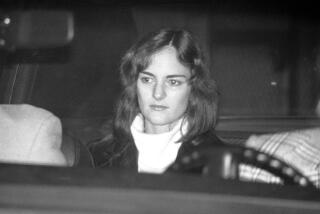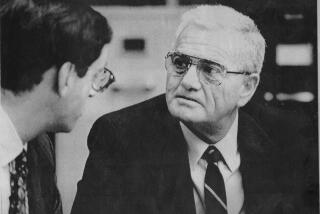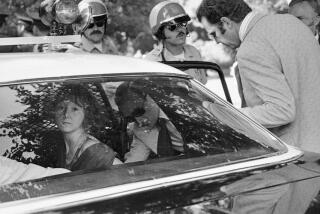Florence Mars, 83; Assisted Probe of 1964 Klan Slayings
The talk around town made it easy for most people in Philadelphia, Miss., to dismiss the disturbing events that began in the summer of 1964.
People said the disappearance of three civil rights workers who had come to register black people to vote was just a hoax, invented by outside agitators. News that a black church supposedly had been burned down by the Ku Klux Klan was part of the publicity stunt too.
Most of the white population seemed to believe the hoax theory. Florence Mars, a petite 41-year-old businesswoman who marched to her own beat, did not. Mars listened, watched and questioned, even confronting the editor of the local newspaper about coverage of the violence.
Long before searchers uncovered the bodies of civil rights workers Michael Schwerner, 24, James Chaney, 21, and Andrew Goodman, 20, in an earthen dam, Mars knew they had been slain.
In the years after the deaths, her willingness to speak up transformed Mars into an important chronicler of one of the most wrenching incidents of the civil rights movement.
Mars, who was one of the few to cooperate with FBI agents investigating the slayings and who told of the turbulent times in her 1977 book, “Witness in Philadelphia,” died April 23 at her home in the town. She was 83 and had suffered from a number of serious illnesses.
The case that changed her life and thrust her hometown into the national news grabbed headlines again last year when a judge sentenced then-80-year-old Klan leader and preacher Edgar Ray Killen to prison for his role in the crime.
“I shudder to think how little progress we would have made if not for Florence,” said Fenton DeWeese, a local attorney and member of the Philadelphia Coalition, a multiracial group that lobbied the state to reopen the case. “She was our conscience, our guide along the path to resolution and redemption for our community.”
In 1964, Philadelphia, in Neshoba County, was a small, insular town where a belief in white supremacy was an invisible hand, directing people’s public lives.
“I thought it was very unfair, and I felt very sorry for the Negroes, and I was glad that I was not a Negro,” Mars said in a 1978 interview for the Mississippi Oral History Program of the University of Southern Mississippi.
Mars belonged to a prominent and wealthy family with deep roots in Neshoba County. Born Jan. 1, 1923, she spent all her childhood in Philadelphia, a place she thought of as “just about the center of the universe.”
A bout with polio as a child left one leg shorter, and she was always small of stature. But in school she was a deep thinker who excelled at debate.
“You didn’t wonder how she felt; she let it be known immediately,” said her childhood friend Gerald “Boots” Howell. “She worked for those who didn’t have what she did.”
Mars left home to attend Millsaps College in Jackson, Miss., and the University of Mississippi. Later she worked for Delta Air Lines in Atlanta during World War II and as a photographer in New Orleans. A jazz aficionado, she became a collector and connoisseur of New Orleans jazz, a painter and a writer.
In 1962, after a trip to Europe, she returned to Neshoba County for good. She owned a cattle farm and a few years earlier had purchased the Neshoba County Livestock Auction Sale. By then her prism on race, on the world, had expanded.
Around the country, the civil rights movement was forcing change. In Philadelphia, where African Americans could not vote, the idea of change evoked fear among some in the white population.
Mount Zion United Methodist, an African American church whose members had expressed interest in serving as a Freedom School, received a visit from the Klan, which beat three members of the congregation. That night the church was burned down.
On June 21, 1964, Schwerner, Goodman and Chaney visited the church. Later, as they left town, a sheriff’s deputy stopped them for speeding, jailed them for six hours and released them in the dead of night. About two months later their bodies were found.
In the aftermath, Mars was able to view her town up close and from a distance, resulting in an account that former New York Times executive editor Turner Catledge once said endowed Philadelphia’s tragedy “with a significance that transcends the stereotyped meanness, bigotry and hatred that kept the incident in newspaper headlines and on television screens.”
Each day she watched Klansmen get together in the town square, men “who knew a murder had been committed and knew that it was ‘theirs.’ Yet, they claimed loudly as anyone that it was a hoax and probably helped convince the town that it was,” Mars wrote in “Witness in Philadelphia.”
After the killings, Mars, her Aunt Ellen and others who questioned the hoax theory attended a town meeting, organized by the Klan to deal with civil rights workers.
“Then the chairman emphasized the importance of keeping the decision that had been reached ‘within this room.’ ... Meanwhile, Aunt Ellen was taking notes to give to the FBI.”
Eventually Mars testified in front of a grand jury investigating the murders. For telling the truth she was ostracized, threatened and driven out of business.
The Klan launched a boycott that ruined her cattle auction and forced her to sell. She was jailed on a bogus charge of drunk driving, part of a long campaign of harassment. Pressure forced her to resign as a Sunday school teacher. Mars never married. She is survived by a godson, Mark Howell, and a cousin.
In 1967, several men from Neshoba County were convicted and sent to prison for the killings. If the Klan had sought to frighten her into silence, it failed. Ten years after the first trial she wrote her book, which displeased some who wished she would just “let it alone,” she said.
Decades later, she supported efforts to reopen the case and retry Killen for the killings, DeWeese said.
She was at his trial “every day, every minute, sitting in her wheelchair taking it all in,” DeWeese said. “She was overjoyed that he was finally convicted for those evil crimes.”
More to Read
Sign up for Essential California
The most important California stories and recommendations in your inbox every morning.
You may occasionally receive promotional content from the Los Angeles Times.










